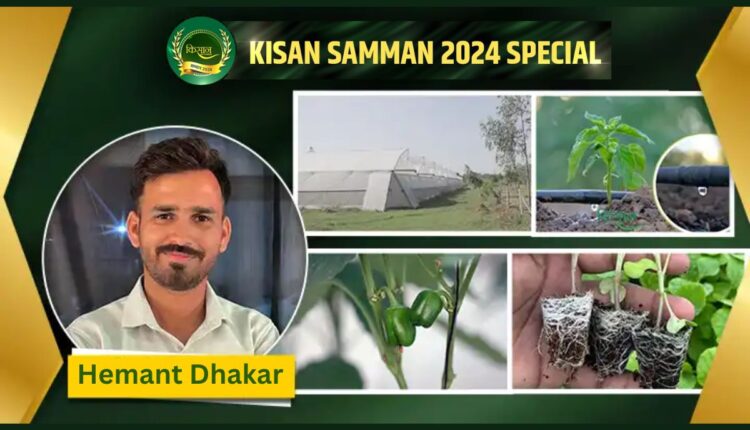Hemant Dhakar’s Initiative in Protected Farming
Hemant Dhakar belongs to Khachrod village of Ujjain district of Madhya Pradesh. Born in 1996, Hemant has adopted modern and protected farming, breaking away from traditional farming. His thinking and hard work have not only strengthened his financial condition, but have also made him an inspiration for local farmers. Currently, he works on preparing seedlings in polyhouse, which is an attempt to bring a revolution in farming using new techniques.
Hemant Dhakar’s beginning of protected farming
Hemant says, “In traditional farming, we always had to suffer losses due to uncertainties of climate and weather. That is why I decided to adopt protected farming. Through polyhouse, I can provide a favorable environment to the crops, which has improved both the quality and quantity of production.”
Under protected farming, Hemant started preparing nursery of plants in polyhouse. In polyhouse technology, plants are grown in controlled temperature, humidity and environmental factors. This protects crops from weather.
Use of techniques and process
The following techniques are used in Hemant’s polyhouse:
1. Soil Steaming: Soil is sterilized before sowing seeds.
2. Drip Irrigation: To save water and deliver appropriate amount of water to the plants.
3. Controlled Environment: Temperature and humidity are controlled inside the polyhouse, which helps plants grow faster.
4. Organic Nutrients: Organic fertilizers are used instead of chemical fertilizers.
Hemant says that he has prepared tomato, capsicum and flower seedlings in his polyhouse. Every season, he prepares a nursery of about 30,000 plants.
Hemant Dhakar’s economic success and earnings
Hemant’s annual income range is Rs 21-30 lakh, which shows how protected farming has strengthened his financial position. He says, “With the help of polyhouse, not only production has increased, but quality has also improved. The demand for our plants is increasing in the market, which is constantly increasing our earnings.”
He sells his prepared plants in local and national level markets. Customers give him orders again and again due to the quality of his plants. Inspiration for local farmers Hemant believes that protected farming is an important medium to bring change in Indian agriculture. He has told the farmers of his village and surrounding areas about the benefits of this method. “We have seen that if the right technology and schemes are used, the income of farmers can be doubled. I have inspired many farmers to start polyhouse farming.” He also taught farmers how farming can be made more profitable by using drip irrigation and organic nutrition. Benefits and support of government schemes
Currently, Hemant has not availed any government scheme, but he believes that if he had received government grants and subsidies, he could have expanded his polyhouses. Various schemes of the Government of India and the state government, such as the Pradhan Mantri Krishi Sinchai Yojana (PMKSY) and the Rashtriya Krishi Vikas Yojana (RKVY), are suitable for promoting protected cultivation.
According to Hemant,
“If farmers are given the right information about these schemes, the number of farmers adopting protected cultivation can increase rapidly.”
Future plans
Hemant dreams of developing it as a model farm by increasing the number of his polyhouses. He wants to make it a training center where other farmers can come and learn modern farming techniques.
“Our goal is that more and more farmers of our village and district adopt protected cultivation and increase their income.”
He is also working to promote organic farming and uses organic manure and organic pesticides on his farm.
Advantages and challenges of protected farming
According to Hemant’s experience, protected farming has many advantages:
1. Higher quality: Growing crops in a controlled environment improves their quality.
2. Higher production: Production is higher in protected farming as compared to traditional farming.
3. Less dependence on weather: Crops can be protected from the uncertainties of weather.
4. Water saving: The use of drip irrigation reduces water consumption to a great extent.
However, Hemant also points out that the initial investment in adopting this method is high. He hopes that the government will provide more support to farmers investing in this field.
Conclusion
Hemant Dhakar has not only strengthened his financial condition with his hard work and foresight through protected farming, but has also become an inspiration for other farmers. His story proves that if the right technology and schemes are used, Indian farmers can make their mark at the global level.
Hemant believes, “Protected farming is not just a technique, but it is a new opportunity for farmers. We have to adopt it and strengthen our agriculture sector.”
Hemant believes, “Protected farming is not just a technique, but it is a new opportunity for farmers. We have to adopt it and strengthen our agriculture sector.”
Looking at his success, it can be said that the future of Indian agriculture depends on protected farming and modern techniques. If farmers get the right direction and support, they can not only increase their income but also make India self-reliant in the agricultural sector.
Contact us- If farmers want to share any valuable information or experiences related to farming, they can connect with us via phone or whatsApp at 9599273766 or you can write to us at [email protected]. Through Kisan of India, we will convey your message to the people, because we believe that if the farmers are advanced then the country is happy.
You can connect with Kisan of India on Facebook, Twitter, and WhatsApp and Subscribe to our YouTube channel.



